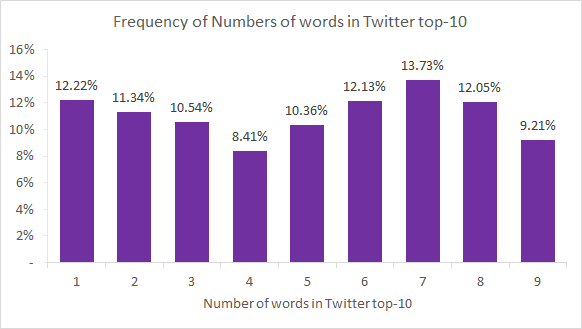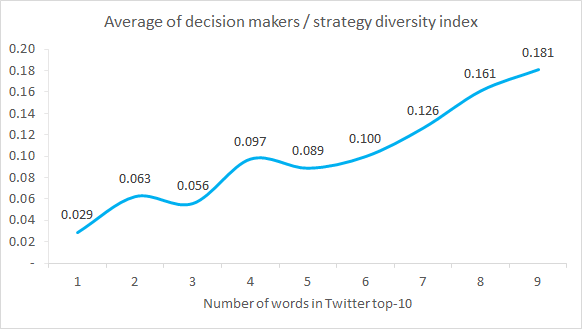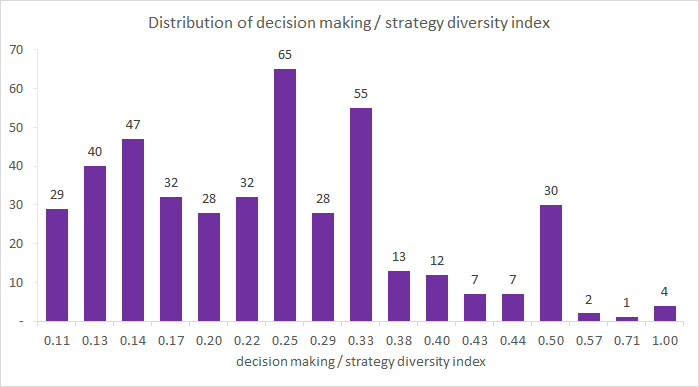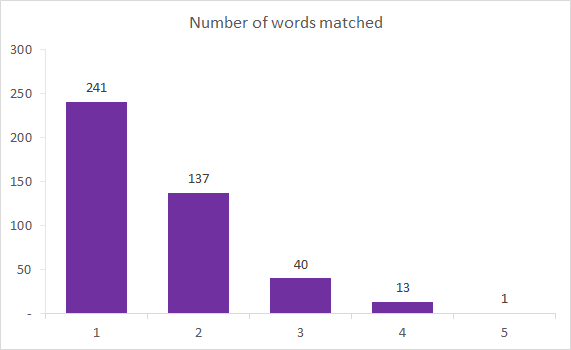Nowadays there is almost no startup left that would work in one narrow field. All the successful cases appear at the intersection of different industries. Therefore, the task of each fund is to determine in its strategic direction the set of industries that will not only be required separately in the future, but also within the interaction between its elements that will cause a synergistic effect for the entire portfolio. At the same time, the apparatus for making key decisions of the fund consists of employees (partners), each of whom has a unique set of skills and past experience that gives this employee expertise in a particular area.
In this article, we analyzed how widespread are the differences between the fund’s strategy for selecting industries for its portfolio compared with the industries that its key employees are interested in. To accomplish this task we compared the top 10 most popular industries in the portfolio of each fund and the top 10 industries that the key people of this fund mention on their Twitter. We took only those funds that have 2 or more unicorns in their portfolio for our analysis.
We have analyzed the Twitter accounts of key personnel in 1129 funds. The number of industries mentioned by them is almost equally distributed between 1 and 9. Most often, one representative mentions 7 industries (which is true for 155 funds and 13.75). The least often number of the industries mentioned is 4 (8.41% or 95 funds).
This situation confirms our hypothesis that most employees have a very narrow profile of their interests. Of course, we can assume that mentioning of investment areas on Twitter is not related to real investments controlled by this person. Yet again, the investor cannot succeed with startups whose market and field of activity are alien to him. Therefore, by default, his interest in topics indirect to his investment is implied.

We have calculated the decision-makers/strategy diversity index for all funds by comparing top-10 most frequently mentioned industries with the top-10 company focus industries. The number of matches for each fund is then divided by the total number of industry words mentioned on Twitter. Unsurprisingly, the average value of decision makers/strategy diversity index rises with the increase of the number of industry words mentioned in Twitter, as the probability of at least one word to be matched increases. The overall average value of the index is 0.099.
This index, although being low for most funds, still allows us to compare funds among themselves. The purpose of this comparison is to try to see which funds have a gap between the fund's strategy and the interests of its key employees. The larger this gap is, the greater the likelihood that the fund will not achieve successful exits for its investment portfolio in the long run.

We have found that in most cases (697 or 62%) there is no connection between tweets published by funds’ employees and funds’ main industry focuses. For funds where at least 1 industry word is matched, 82% of observations (369 cases) lie within the range 0.11–0.33 of decision making/strategy diversity index. All 4 funds with a 100% match between their employees’ top-10 Twitter focus and top-10 company focus have only 1 industry mentioned.
The complete absence of coincidences between the fund’s strategy and the topics that its employees discuss on Twitter in more than half of the cases studied suggests that the problem exists and it is significant. Such funds should take measures to narrow the gap found: reviewing the existing strategy, hiring new profile partners, exploring new industries with existing partners.

For those funds where at least one industry word matched between top-10 company focus industries and the top-10 industry mentions in their employees’ tweets, most of the observations have 1 or 2 words matched – 241 and 137 matches respectively.
This data doesn’t mean additional problems; on the contrary, it confirms the hypothesis that employees have different focuses. And even one intersection between the fund’s strategy and the expertise of a person is enough for his/her successful work in this direction.

In the top-17 of funds ranked by decision-makers/strategy diversity index, 16 funds are located in the United States and 1 – in the United Kingdom. Among the mentioned United States funds 11 out of 17 are located in California, and 3 are located in New York.
This geographical breakdown of the index we are investigating is caused by a more mature VC culture in the USA. The funds that are in the top of our rating should be look up at as a success story for building the right relationship between the fund’s investment strategy and the expertise of its employees, their policies regarding this topic can be implemented to bridge gaps in other funds.
Table I. Top-17 funds ranked by decision-makers/strategy diversity index*
| Name | decision makers / strategy diversity index | Country | State |
| Boost VC | 0.71 | United States | California |
| Polychain | 0.57 | United States | California |
| Pantera Capital | 0.57 | United States | California |
| Lowe's Ventures | 0.50 | United States | North Carolina |
| Next47 | 0.50 | United States | California |
| Digital Currency Group | 0.50 | United States | New York |
| Workday Ventures | 0.50 | United States | California |
| Zetta Venture Partners | 0.50 | United States | California |
| March Capital Partners | 0.50 | United States | California |
| VTF Capital | 0.50 | United States | California |
| StartUp Health | 0.50 | United States | New York |
| NextWorld Capital | 0.50 | United States | California |
| Emergence | 0.50 | United States | California |
| SAIC Venture Capital | 0.50 | United States | Nevada |
| Abingworth | 0.50 | United Kingdom | England |
| Citigroup | 0.50 | United States | New York |
| Craft Ventures | 0.50 | United States | California |
Note: The above funds have at least 2 words matched
Looking closer at what industries those 17 funds really focus on we have found out that they are primarily focused on Blockchain and Cryptocurrency, FinTech and Financial Services, Information technologies and Software (see Table II).
Most industries from this list appeared on the market relatively recently. This may be the reason for these funds to be on the top of the list because of their flexibility, innovativeness, and willingness to adapt to modern technologies. In addition, this homogeneity also speaks of the general mood of key persons and funds of the venture capital market.
Table II. Top-5 Industry focus of Top-17 funds ranked by decision-makers/strategy diversity index
| Name | decision makers / strategy diversity index | Top-5 Industry Focus |
| Boost VC | 0.71 | Bitcoin, Virtual Reality, FinTech, Cryptocurrency, Software |
| Polychain | 0.57 | Blockchain, Cryptocurrency, Financial Services, Software, Bitcoin |
| Pantera Capital | 0.57 | Blockchain, Bitcoin, Cryptocurrency, Internet, Financial Services |
| Lowe's Ventures | 0.50 | Software, Real Estate, Education, Impact Investing, Consumer |
| Next47 | 0.50 | Software, Information Technology, Enterprise Software, Manufacturing, Wireless |
| Digital Currency Group | 0.50 | Bitcoin, FinTech, Blockchain, Financial Services, Cryptocurrency |
| Workday Ventures | 0.50 | Software, SaaS, Artificial Intelligence, Recruiting, Big Data |
| Zetta Venture Partners | 0.50 | Software, Artificial Intelligence, SaaS, Machine Learning, Analytics |
| March Capital Partners | 0.50 | Software, Analytics, Network Security, Security, SaaS |
| VTF Capital | 0.50 | E-Commerce, Software, Fashion, Mobile, Internet |
| StartUp Health | 0.50 | Health Care, Information Technology, Medical, Wellness, mHealth |
| NextWorld Capital | 0.50 | Enterprise Software, SaaS, Analytics, Software, Big Data |
| Emergence | 0.50 | Software, SaaS, Enterprise Software, Internet, Cloud Computing |
| SAIC Venture Capital | 0.50 | Software, Automotive, Artificial Intelligence, Machine Learning, Autonomous Vehicles |
| Abingworth | 0.50 | Health Care, Medical, Pharmaceutical, Therapeutics, Medical Device |
| Citigroup | 0.50 | Financial Services, Finance, Software, Internet, Information Technology |
| Craft Ventures | 0.50 | Software, Blockchain, Cryptocurrency, Financial Services, Transportation |
Most of the top-10 industries frequently mentioned in Twitter are also in line with the Top-5 focus industries of the funds with the biggest decision-makers/strategy diversity index from Table II.
Only Software and SaaS are common for both fund employees’ tweets and top-10 their funds’ actual focus. On the other hand, there is a shift from Internet, Information Technologies, E-Commerce and Mobile in most common company focus industries to iOS, Blockchain, Fintech and Bitcoin in top-10 industries most frequently mentioned in Twitter.
The general section shows the overall market picture which consists of the difference between the focus of the funds and the "live" topics that are discussed by the employees of these funds. This suggests that overall fund strategies are too conservative for their active employees.
Table III. Top-10 industries in top-10 Company focus and top-10 Twitter focus
| Top-10 most frequent industries companies are focused on | # of appearances in top-10 Company focus | Top-10 industries most frequently mentioned in Twitter | # of appearances in top-10 industries mentioned in Twitter |
| Software | 9258 | Security | 351 |
| Internet | 7321 | Software | 335 |
| Health Care | 6989 | iOS | 288 |
| Information Technology | 5896 | Blockchain | 275 |
| E-Commerce | 5784 | FinTech | 240 |
| Biotechnology | 4918 | Bitcoin | 214 |
| SaaS | 3937 | SaaS | 203 |
| Mobile | 3453 | Energy | 136 |
| Medical | 3379 | Credit | 133 |
| Enterprise Software | 3183 | Legal | 124 |
We have confirmed our hypothesis about how widespread are
the differences between the fund's strategy for choosing the industries for its
portfolio in comparison with the industries that its key employees are
interested in. This is expressed in the fact that more than half of the funds
do not have a single overlap with what its employees are interested in, and as
a result, they gain expertise in these
industries.
We have developed an index that helps to compare funds for how large the gap is
and how urgently these funds need to review their activities on this issue.
We have also determined which funds could be used as an example of eliminating this difference. Additional
attention was paid to the analysis of specific industries. A review of this
list could positively affect the performance of investment portfolios.
For startup founders, this can be an important food for thought on the topic of
how important is finding the topic in personal contact with partners for whom
they are relevant, rather than
the cold bombardment of all employees with a fund that would interest them.

